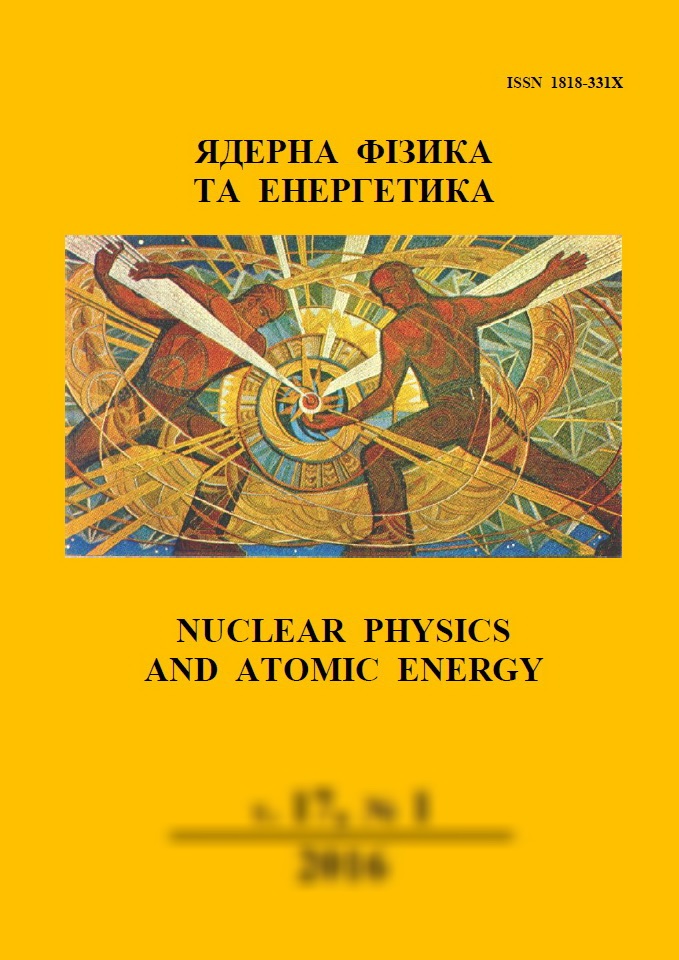 |
Ядерна фізика та енергетика
Nuclear Physics and Atomic Energy
ISSN:
1818-331X (Print), 2074-0565 (Online)
Publisher:
Institute for Nuclear Research of the National Academy of Sciences of Ukraine
Languages:
Ukrainian, English
Periodicity:
4 times per year
Open access peer reviewed journal
|
Nucl. Phys. At. Energy 2021, volume 22, issue 3, pages 263-271.
Section: Radiobiology and Radioecology.
Received: 20.01.2021; Accepted: 19.07.2021; Published online: 22.02.2022.
 Full text (ua)
Full text (ua)
https://doi.org/10.15407/jnpae2021.03.263
Tritium in the hydro-ecosystem of the South-Ukrainian Nuclear Power Plant
L. I. Grygorieva*, А. O. Aleksieieva, O. V. Makarova
Petro Mohyla Black Sea National University, Mykolaiv, Ukraine
*Corresponding author. E-mail address:
kafecobezpeka@ukr.net
Abstract:
Based on the results of radioecological studies in the aquatic ecosystem of the South-Ukrainian Nuclear Power Plant region (SUNPP), the tritium content in technological reservoirs (cooling pond, biological pond of the cleaning station, splash pool) and adjacent surface and groundwater bodies were analyzed. It is shown that the average annual volumetric activity of tritium in the water of technological reservoirs of the SUNPP during 2014 - 2018 is kept at the level of 110 - 160 Bq/l, with a tendency to increase with an average annual rate of 12 - 13 Bq/l, which correlates with a decrease in the volume of blowdown water discharge from the cooling pond (about 8698 thousand m3 per yr). Higher levels of volumetric activity of tritium were registered in the water of technical wells - leakage markers in the technical system, which, moreover, are fed from the pools of cooling towers and spray units. The tritium content in the bioponds of the sewage system of the SUNPP decreased from more than 1000 Bq/l in the early 1990s to 100 - 130 Bq/l in 2017 - 2018, which led to a decrease in its level in the Trikratsky reservoir and should affect lowering its level in groundwater sources, which are located below the natural runoff. Taking into account the physicochemical properties of tritium and the conclusions of well-known scientists about the extremely rapid accumulation of tritium in the environment, the necessity of hydroecological monitoring of the tritium content in surface water bodies is substantiated, the water of which is used for irrigation of agricultural crops and which are hydrodynamically connected with the technological water bodies of the SUNPP, as well as sources of drinking water located downstream of the natural runoff from the technological reservoirs of the nuclear power plant.
Keywords:
tritium, hydroecosystem, technological reservoirs, radioecological monitoring, industrial and municipal sewerage.
References:
1. Operational & Long-Term Shutdown Reactors. IAEA. Power Reactor Information System.
https://pris.iaea.org/PRIS/WorldStatistics/OperationalReactorsByCountry.aspx
2. Yu.A. Egorov. On the radiation hazard of tritium produced at nuclear power plants. Izvestia Taganrog Radio Engineering University 6 (2002) 10. (Rus)
3. E.L. Telushkina. Tritium in the environment near nuclear fuel cycle facilities. Gigiyena i Sanitariya 3 (1983) 62. (Rus)
4. D.I. Gudkov. Tritium in the water of the Dnieper and its reservoirs. Gidrobiologicheskiy Zhurnal 31(3) (1995) 95. (Rus)
5. V.L. Usachev. Tritium in industrial reservoirs of Production Association “Mayak”. In: "Tritium is Dangerous." Digest of Materials (Chelyabinsk, 2001) p. 40. (Rus)
6. V.V. Zhuravkov. Determination of background levels of tritium content in open hydrological objects in the construction area of the Belarusian NPP. Ekologicheskiy Vestnik 2 (32) (2015) 5. (Rus)
https://elib.bsu.by/bitstream/123456789/165879/1/ilovepdf_com-5-10.pdf
7. O.A. Nikolin. Tritium in aquatic ecosystems of the Ural region. The Thesis of the Candidate of Biological Sciences (Perm, 2008). (Rus)
8. I.I. Silin. Dangerous tritium. In: Global Ecological Processes. Proc. of the Int. Sci. Conf. Ed. V.V. Snakin (Moskva: Academia, 2012) p. 397. (Rus)
9. L.I. Grygorieva, Yu.A. Tomilin. Formation of Radiation Load on a Person in the Conditions of the South of Ukraine: Factors, Forecasting, Countermeasures (Mykolaiv: Petro Mohyla Black Sea National University Publishing House, 2009) 230 p. (Ukr)
10. Yu.M. Zhegulina. Transboundary impact of Chernavodsk and Rivne Nuclear Power Plants on tritium pollution of the Danube and Styr rivers. The Thesis of the Candidate of Technical Sciences (Kharkiv, 2017) 128 p. (Ukr)
11. Council Directive 98/83 / EC of November 3, 1998, on "The quality of water intended for human consumption". (Ukr)
https://zakon.rada.gov.ua/laws/show/994_963
12. Radiation situation around SUNPP location for 2014 - 2018. Reports of the SUNPP External Dosimetry Laboratory, 2019, 24 p. (Ukr)
13. V.M. Vasylchenko et al. Monitoring of tritium in natural surface water bodies of Ukraine. Yaderna Enerhetyka ta Dovkillya 1 (2013) 14. (Ukr)
http://npe.org.ua/wp-content/uploads/2019/02/1_2013.pdf
14. Tritium in underground horizons in the SUNPP region. Report on research and development of NPP "Yuzhgeologiya". No. 87/5-1 (Odessa, 1994) 44 p. (Rus)
15. L.I. Grygorieva, Yu.A. Tomilin. Assessment of the degree of 3H pollution of the surface water bodies and some sources of drinking water supply in the SUNPP area. Ukrayinskyy Radiolohichnyy Zhurnal 4 (1999) 17. (Ukr)
16. L. I. Grygorieva, A. O. Alekseeva, A. V. Koval. Calculation of the acceptable radionuclide level in irrigation water during irrigation by the method of rain. Nucl. Phys. At. Energy 21(1) (2020) 86. (Ukr)
https://doi.org/10.15407/jnpae2020.01.086
